Projects from PXL-MAD School of Arts treat jewellery as "critical artefacts and cultural symbols"
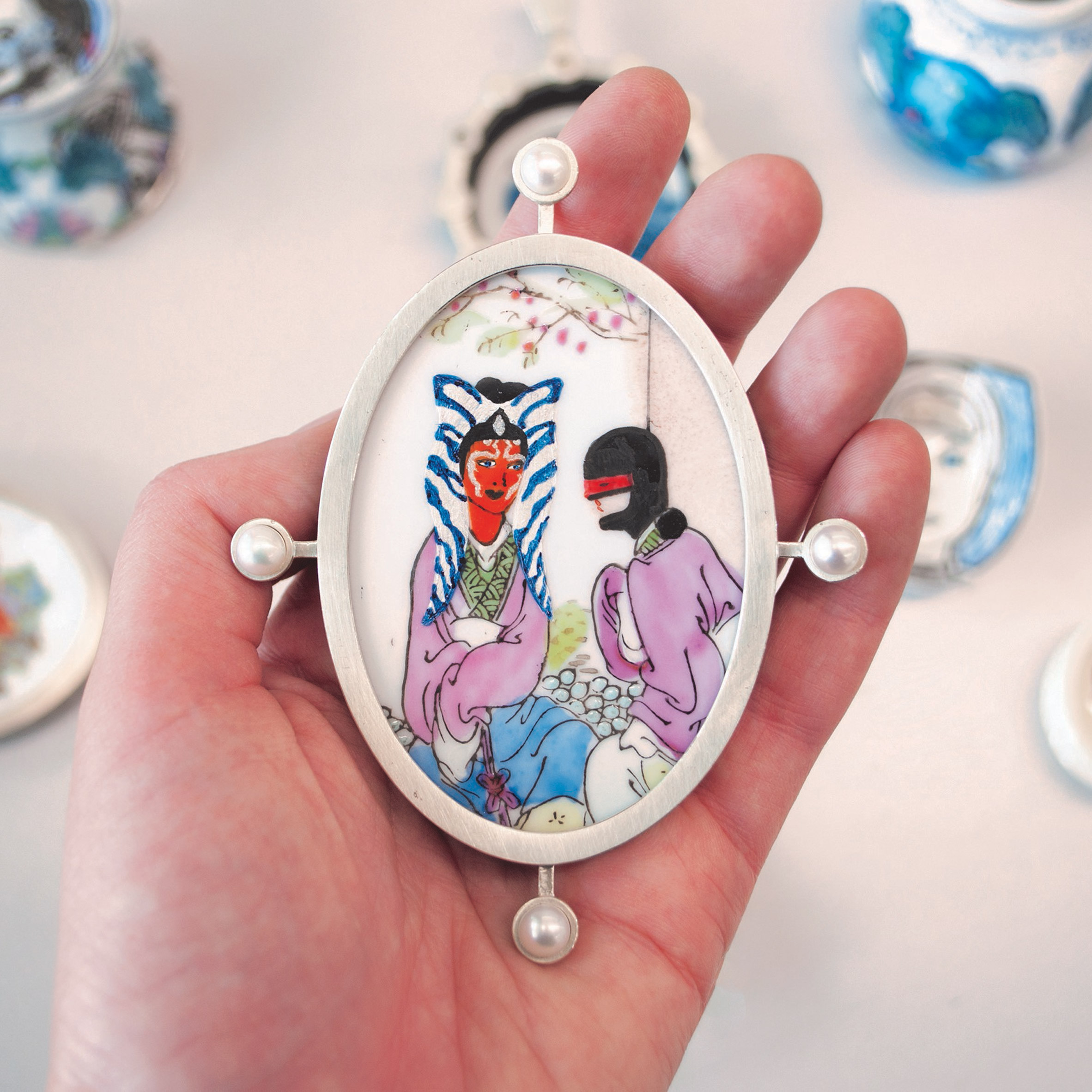
Students from the PXL-MAD School of Arts merged traditional craft techniques and new manufacturing technologies to create the eight jewellery collections featured in this VDF school show.
The projects were designed as part of their master's degree in Jewellery Design, Gold- and Silversmithing, based at the university's campus in Hasselt, Belgium, and utilise materials from repurposed ceramic tableware to found animal bones cast in silver.
MA Jewellery Design, Gold- and Silversmithing, PXL-MAD School of Arts
University: PXL-MAD School of Arts
Course: MA Jewellery Design, Gold- and Silversmithing
Tutors: Nedda El-Asmar, Prof. Dr. David Huycke, Audi Pauwels, Dr. Karen Wuytens, Patricia Domingues and Prof. Dr. Bert Willems
School statement:
"Jewellery Design, Gold- and Silversmithing at the PXL-MAD School of Arts is an artistic, academic educational programme that is divided up into three years of undergraduate and one year of graduate study. The department also offers a pre-masters preparation programme.
"With the support of a team of renowned artists, designers and academics, students are continually encouraged and challenged to further their research skills. Students develop contemporary objects and jewellery as mediums for artistic and narrative expression, as critical artefacts and cultural symbols that evoke communication.
"Fully equipped workshops are provided with the latest technologies to create an inspiring environment where concept and practice are perfectly synchronised. This also stimulates the interaction between traditional crafts and new technology while encouraging a cross-disciplinary approach."
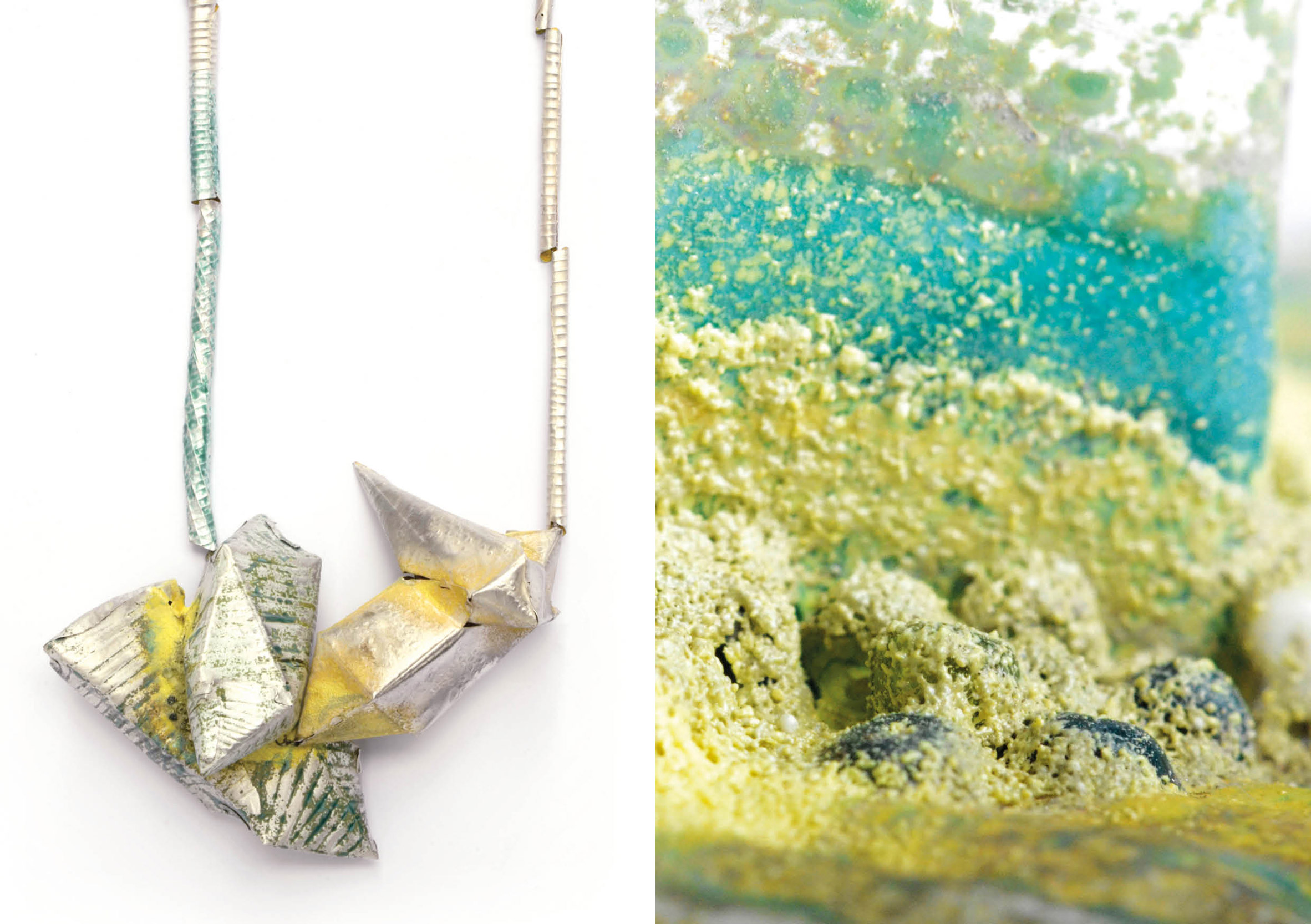
Zooming in, zooming out by Annika Ingelaere
Materials: silver, enamel, glass beads and silver chain
"When you compare a landscape to a zoomed-in image of a seed, certain similarities are apparent. For example, the polygon and the organic surface occurs similarly in both the landscape and the microscopic seed.
"Seeing a zoomed-out image of some of the landscapes we have polluted, a certain aesthetic beauty can be seen. As ironic as it may be, the pollution shows its true form in the colours and rough formations that have spread across the land. The silver jewellery in this project is an investigation into form, colour and the structure found in both nature and pollution."
Website: annikaingelaere.be
Email: annika@ingelaere.be
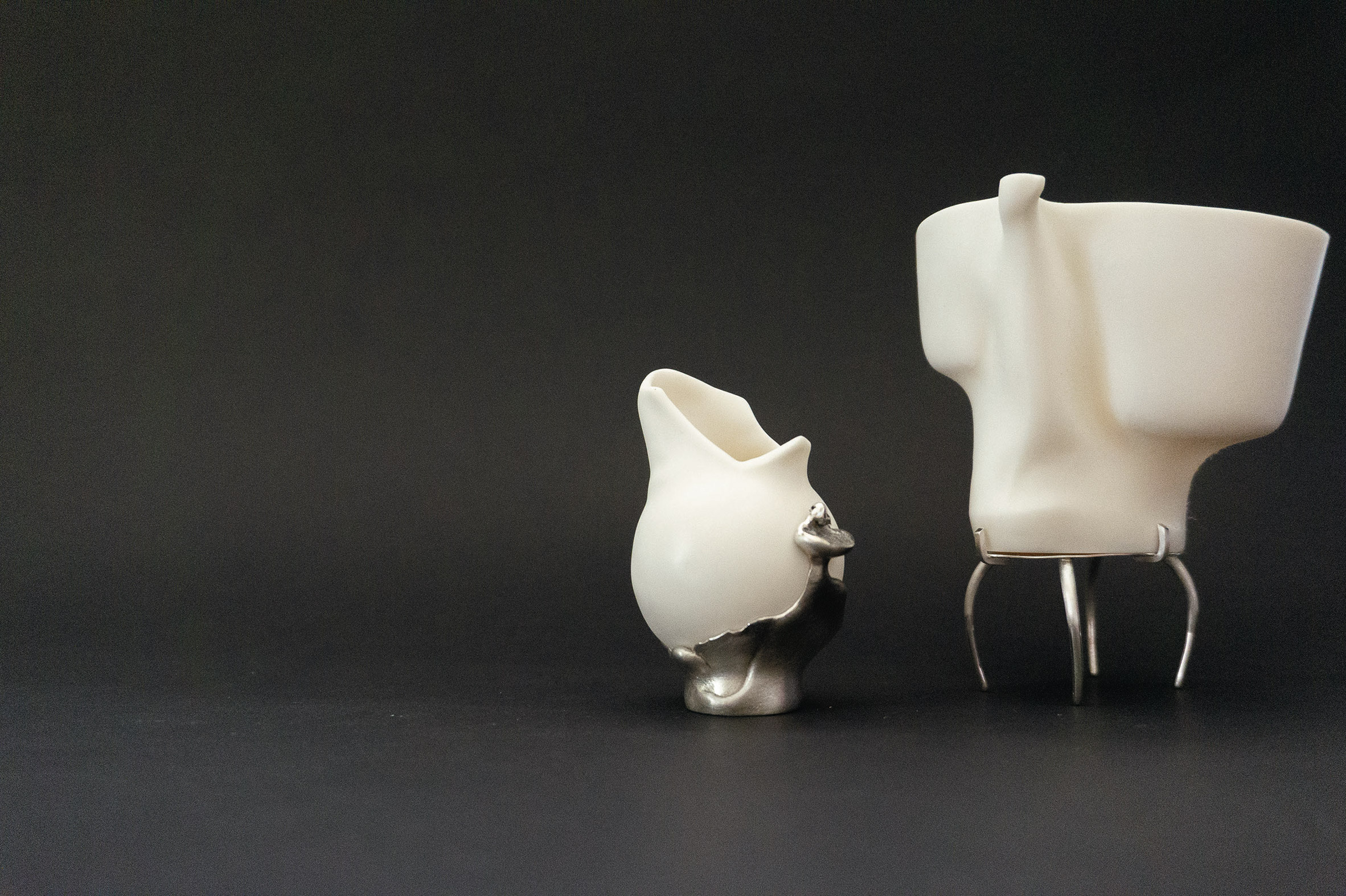
Nonliving creatures by Charlot Claessens
Materials: porcelain and silver
"Now and then when we look at an object it feels familiar. This feeling is hard to describe but we can sometimes recognise human qualities in non-human things. This is called anthropomorphism.
"This project is based on this particular kind of familiarity and wants to emphasise the human qualities present in objects and give them a character. The aim is to create a deeper connection between the user and the object itself. In essence, it's about giving life to the nonliving."
Instagram: @charlotclaessens
Email: Charlot_Claessens@hotmail.com
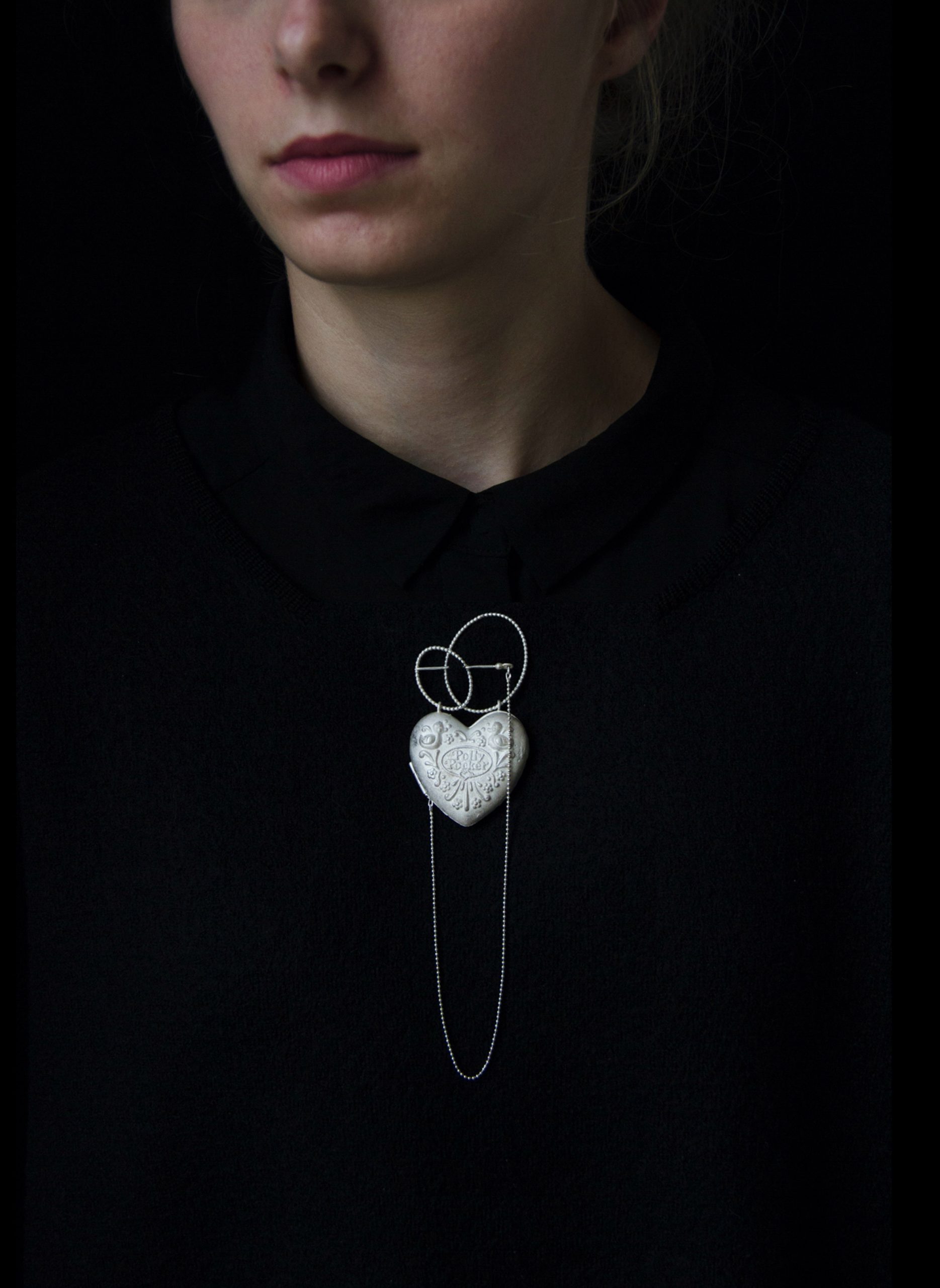
Stilled Sentiments by Charlotte Vanhoubroeck
Materials: sterling silver and enamel
"The first Belgian queen Louise-Marie d’Orléans died in 1850. Her Estate Inventory, a document kept in the State Archives of Belgium, describes and values the 300 items of jewellery that she owned at the time of her death.
"More than a hundred of those are so-called sentimental jewellery pieces. They are carriers of memories and sentiments, which were incorporated as miniature portraits, human locks of hair, engraved messages and so on. Since almost all of Louise's jewellery has gone missing, the inventory functions as an exclusive carrier of the pieces, just as the pieces were carriers of sentiments.
"Based on the descriptions I've resurrected Louise's sentimental jewellery, which was on the verge of fading into oblivion, in a contemporary way. The newly created objects construct an alternative version of the myth around Louise-Marie d’Orléans and will bring this somewhat forgotten queen closer to today's audience."
Website: charlottevanhoubroeck.com
Email: charlotte.vhb.jewellery@gmail.com
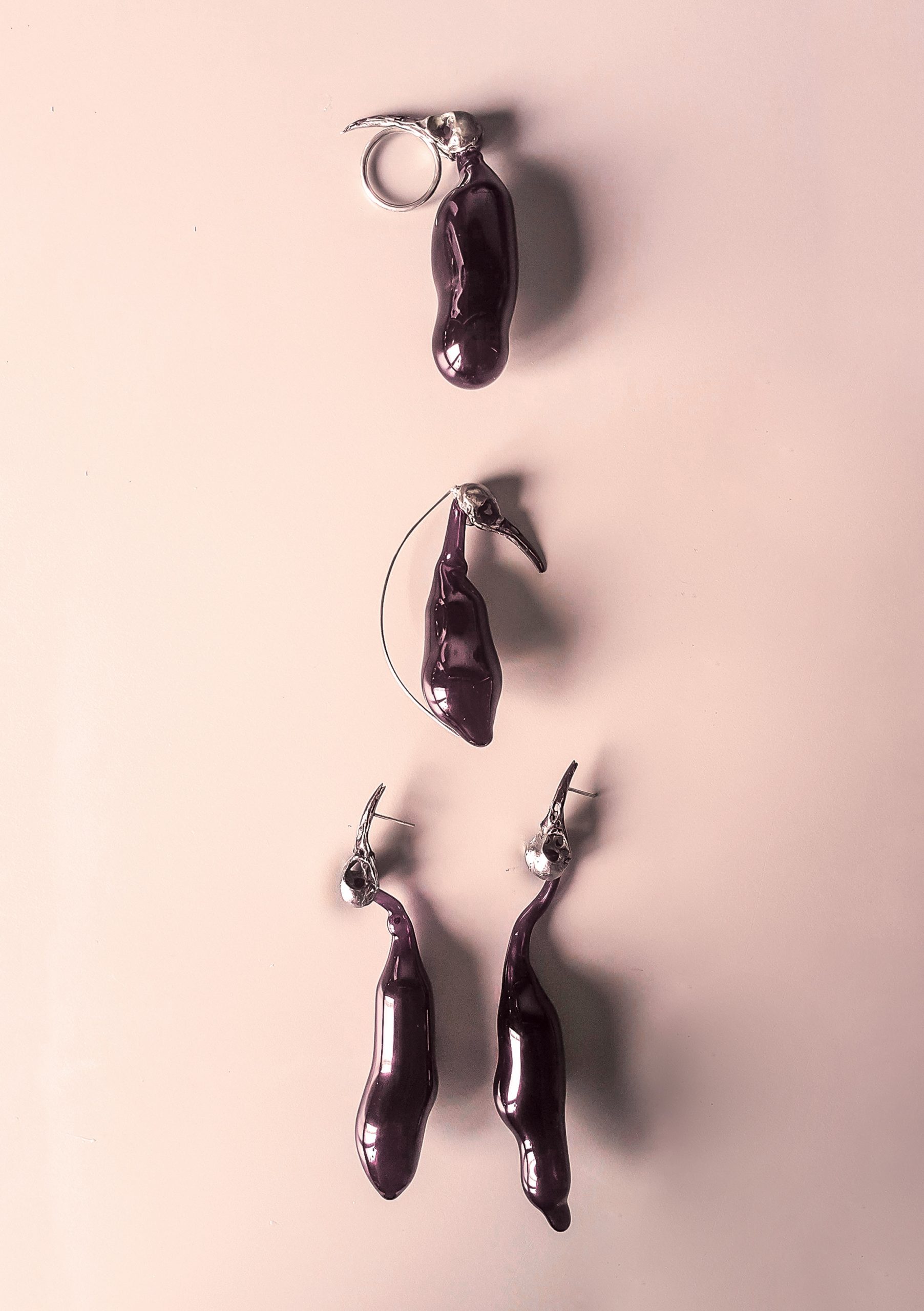
Cutis et Ossium by Magdalena Viljoen
Materials: sterling silver and borosilicate glass
"This contemporary cabinet of curiosities was born out of my nostalgia for my home country of South Africa and its diminishing local wildlife. My fragmented memories of observing it as a child inspired the symbolic metamorphosis of collected animal bones and remnants of skin, transformed into abject specimens.
"With the aim of preserving the delicate details and sense of wonder I encountered upon finding these remnants in nature, I portray them as cherished artefacts. Through a fusion of biomorphic, abstracted glass forms and organic remnants replicated in metal, I hope to create a form of visual fiction that delivers a moment of introspection, attraction and repulsion.
"There is a strong symbiosis between the artificial and the natural, representing the interference of humans with nature. The jewellery depicts curious, exaggerated mutations, envisaging what could happen to animal life in the future if humans continue with practices that pollute and alter the environment."
Instagram: @madeliviljoen
LinkedIn: linkedin.com/madeliviljoen
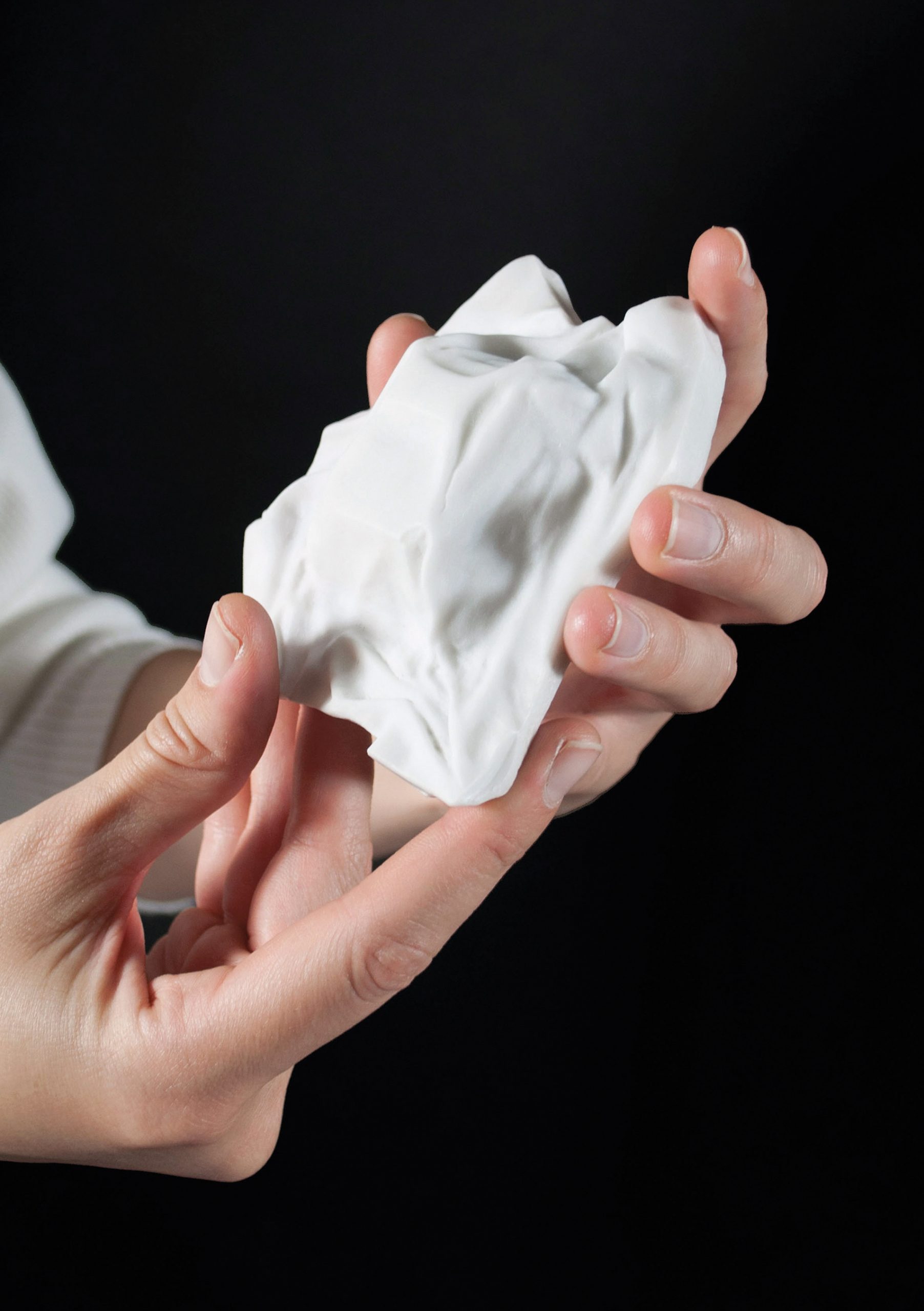
About space and identity by Maria Konschake
Materials: marble and steel
"About space and identity is a visualisation of European cultural identity within the field of jewellery. It deals with the rooms, areas, zones and districts of European history and scrutinizes the connection between jewellery and cultural identity. Five points of view show not only the plurality of cultural memory but also the European struggle between unity and diversity.
"Vergessen is a series of unwearable marble brooch objects that remind us of the things we lost. Prägung is a single pendant that relates to the things that shaped us. Abgrund is the abyss referring to the lowest point we have reached in European history.
Abbild is our portrait, a row of rings and wall objects that visualise the permanence of buildings as an observer of time.
Hoffnung is hope, a series of cups that embodies the positive, shared vision of a European future."
Website: maria-konschake.de
Email: M.Konschake@gmx.de
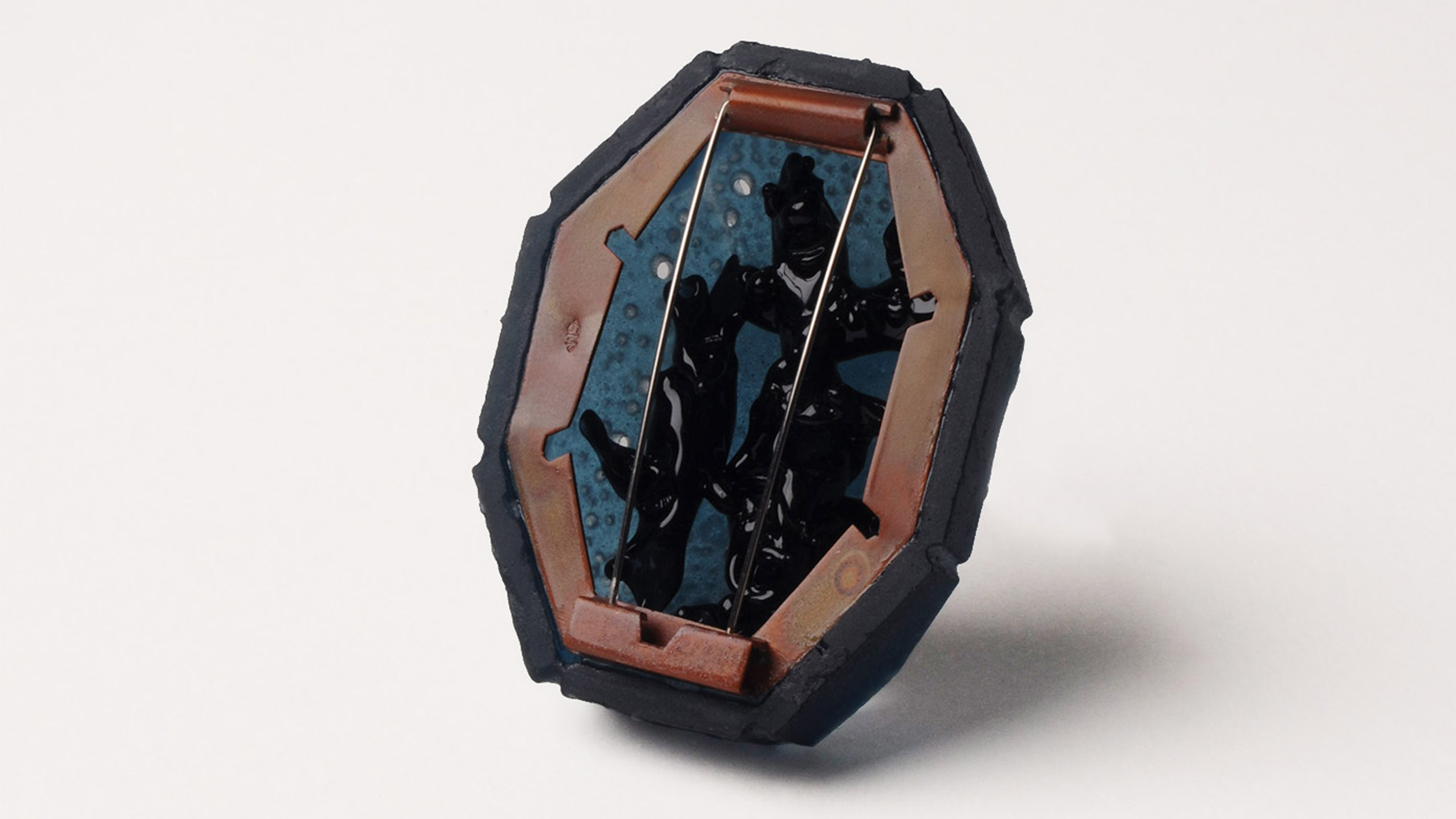
Floating Steps by Simón Mazuera
Materials: glass, copper and steel
"Floating Steps hopes to encourage us to question ourselves and find our true fears hidden in our unconscious. It aims to prompt the wearer to get to know themselves better, starting with the negative aspects in order to ultimately make the positive things inside them flourish.
"These pieces are a reminder that we are vulnerable humans, who constantly, hoplessly strive to be superheroes. The idea of each brooch is to show how fear is inside us, ready to be discovered by an action or decision we make. In this case, the decision is to seek the unknown fears and identify them hidden inside us."
Email: simon@simonmazuera.com
Instagram: @simonmazuera.jewellery
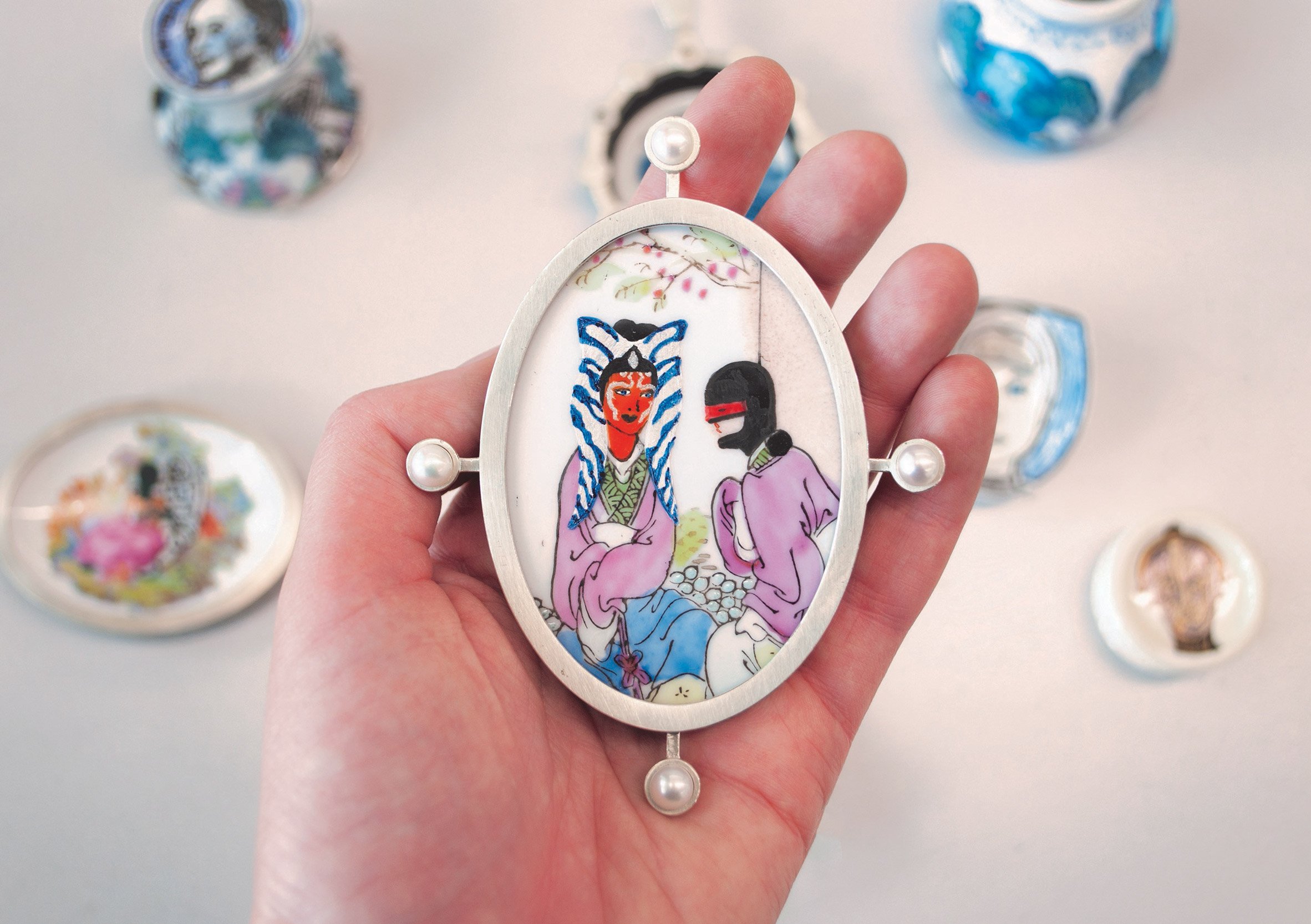
Past Visions of the Future and Other Stories by Sophia le Roux
Materials: reclaimed ceramic, sterling silver, freshwater pearls, porcelain paint and porcelain marker
"In this project, I compose visual narratives inspired by science fiction films from the past century on traditional, second-hand ceramic tableware which are then fragmented and transformed into jewellery. Through interfering with the traditional images and patterns on the ceramic, new narratives are constructed and new meanings created.
"My work engages with the fluid way in which all identity formation is constructed and perpetually adapted to account for changes in our views and world. I hope to expose the dialectical relationship of meaning being transformed and transferred between past, present and future, as well as between us and our material culture.
"Making jewellery from these narrative artefacts is a celebration of the process of narrative construction and its potential to keep up with changing times and perspectives while accounting for a past that keeps on informing our present."
Email: sophialeroux91@gmail.com
Instagram: @mallorn_jewellery
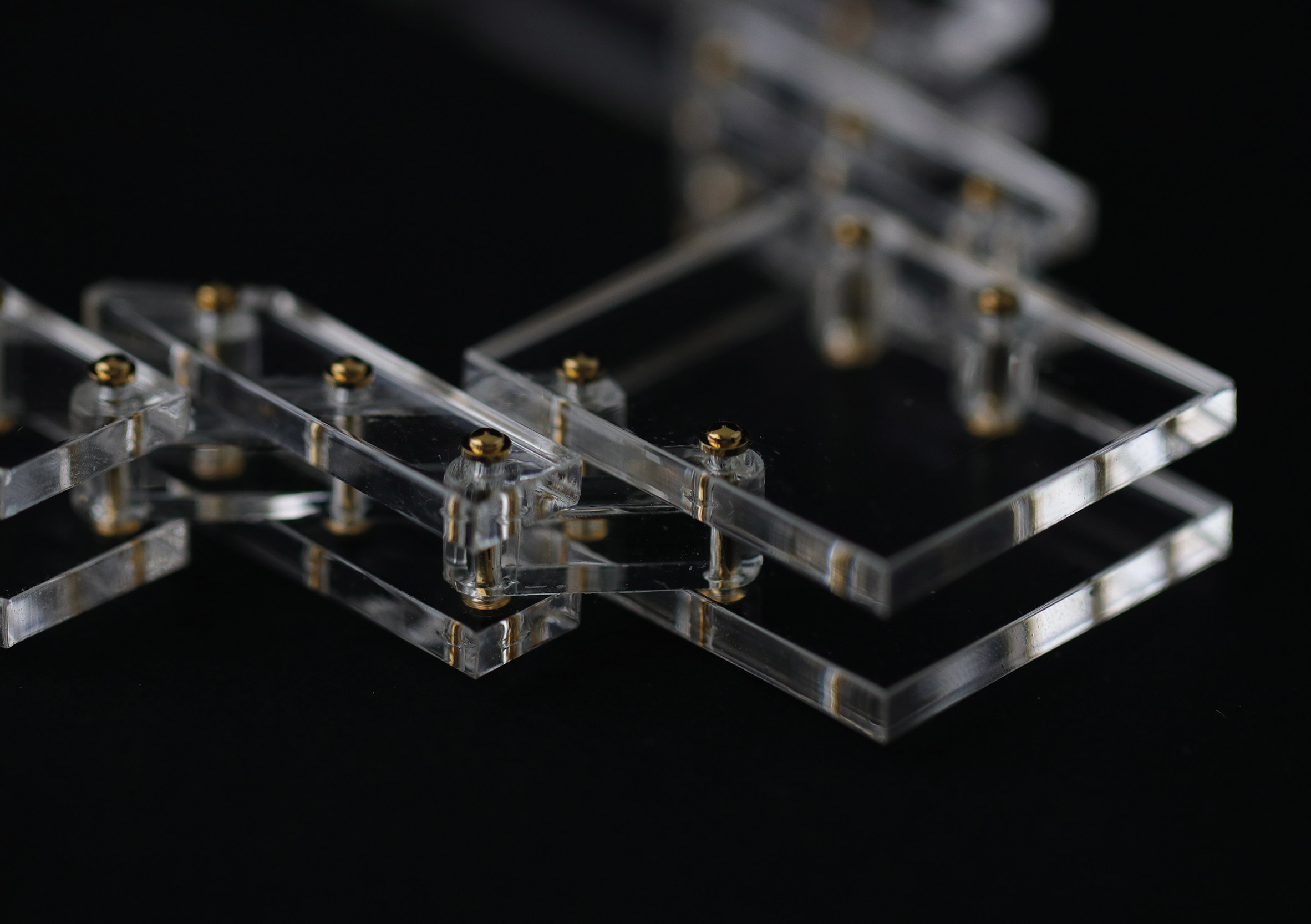
Movement By Hinges by Yann Ceuleers
Materials: plexiglass and brass
"Movement can be interpreted in many ways. It's possible to make anything movable or create the illusion that it is moving. My work explores what makes movement possible, taking the hinge as my main inspiration.
"Through a series of jewellery pieces and objects, the hinge has been reinterpreted in multiple ways. Besides physical movement, movement can also be suggested in a static form. In this project, physical and suggested movement have each been investigated and played with to search for the true meaning of movement."
Email: ceuleers.yann@outlook.com
Virtual Design Festival's student and schools initiative offers a simple and affordable platform for student and graduate groups to present their work during the coronavirus pandemic. Click here for more details.
The post Projects from PXL-MAD School of Arts treat jewellery as "critical artefacts and cultural symbols" appeared first on Dezeen.